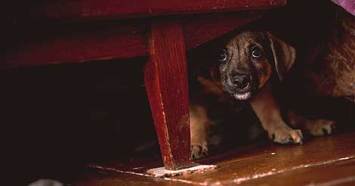
What is it about dogs and thunderstorms?
Dogs can show anxiety or fear with wind, rain, thunder, and lightening. There are a number of storm-specific triggers that make this phobia unique, including abnormally darkening skies, the booming thunder and cracking lightning, the sound of wind or pouring rain, static electricity that builds up during storms, and changes in barometric pressure.
There is no easy “one-size fits all” solution to thunderstorm phobia in dogs, but desensitization training and behavior modification are often both needed.
How to Help Your Dog with Thunderstorm Anxiety Through Training and Behavior Modification
Back to basics.
You need a strong foundation of basic commands such as 'sit' and ‘relax.’ Always reward when the task is successfully accomplished. Once sitting and relaxation have been achieved, the training should be tested in the face of some distraction. If you cannot get your dog to settle and relax in the absence of distractions, it’s not practical to begin your exposure exercises yet.
Introduce imitation storm elements.
It is important to start off with the noise at a volume that does not elicit any distress. The initial sound sometimes may be barely audible. Using a stereo “surround-sound” recording system is more likely to produce a sound that is most similar to the actual stimulus, but it is important to start small with less fear-invoking stimuli and move upward. YouTube videos are a great resource. Additional measures can be taken such as dimming the lights. If you can point a sprinkler at a window during these training session, this may help too if the sound isn't enough. Always use the same room with desensitization therapy.
Practice, practice, practice.
Each day you should spend no more than 5-10 minutes working on this desensitization training. Using a ‘sit’ or ‘relax,’ you should reward if the dog obeys in the face of the stimuli. If the correct response is not achieved, the behavior should be ignored. Training your dog to relax in a specific area (e.g. go to your bed) may be a particularly useful command since the bedding area may further help the dog to relax and settle. Blankets placed over his crate (if you use one) can mute sounds and intensity for some pups.
Keep it positive.
It is important that you don't overdo it and never punish your pet! This can make the thunderstorm phobia and destructive behaviors that follow it even worse. After every few bangs or thunder rolls, give a special treat and engage in play or enjoyable activities. It is important you always end a session on a high note with a good response, even if that means turning the volume right down again.
Reasonable expectations.
It is important not to expect too much, too soon. You have to accept from the outset that the program will take days, weeks, or even months, but eventually your dog should remain relaxed at full intensity noises.
Thunderstorm Desensitization Tips for When Storm Season Begins:
Provide Background Noise for your Dog
When storm season begins, provide background sounds from the radio or television. Other background noises such as a fan running or even “white” noise devices can help to block outdoor noises. As for you, ignore the noises yourself and try to involve your pet in some form of active game or an extra yummy and time-consuming treat.
Get Your Dog a "Storm" Buddy
If you have a friend, relative or neighbor down the street who has a dog that is not scared of loud noises and gets along well with your dog, see if your neighbor will lend her dog for support. Playing with the non-fearful dog may help to encourage your dog to join in and reduce his fear.
Thunder Coats and Other Anxiety-Reducing Apparel
Some dogs respond well to the storm capes and vests that swaddle dogs snuggly and reportedly discharge the static electricity that builds up in the hair of pets and can contribute to the overall fear.
Calming Pheromones for Dogs
Pheromone diffusers, such as DAP (dog-appeasing pheromone) are useful with some patients. These synthetic pheromones may induce relaxation and help modify your dog’s behaviors.
Anti-anxiety Medications
Medicating your dog for storm phobia is also an option if training, behavior modification and desensitization strategies aren’t enough. Anti-anxiety medications may be discussed with your veterinarian but should not be solely relied upon.
Preventing Storm Phobia in your Dog Should Start as Early as Possible
Prevention of noise phobias may be possible through early exposure of the pet to as many different stimuli as possible. Habituation during the early, sensitive period of 3-12 weeks of age may help prevent many of the fears and phobias seen in adult dogs.